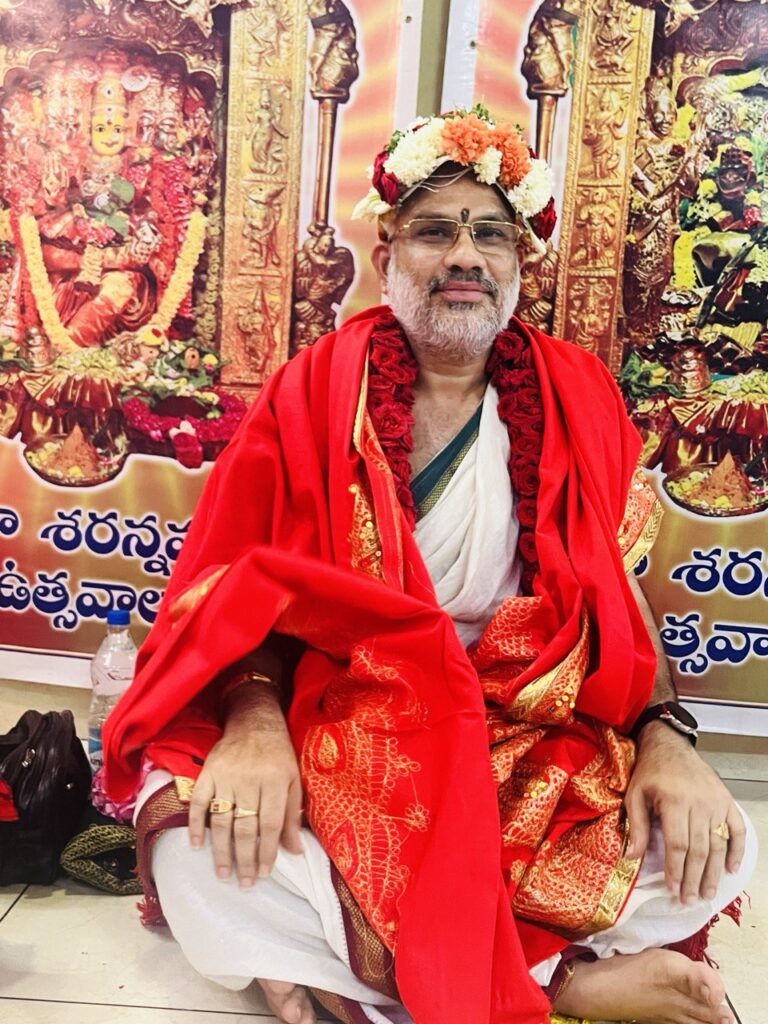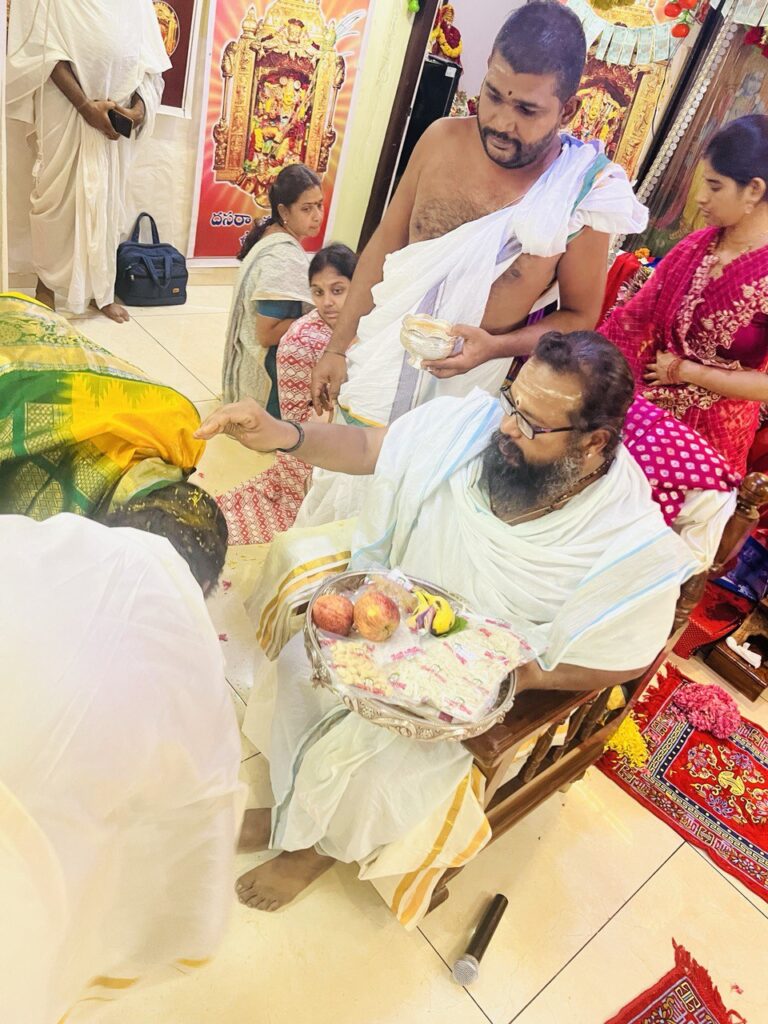
“Veda Ghoshti” (also spelled Veda Goshthi or Veda Ghoshtee) is a Sanskrit term that literally translates to “Vedic assembly,” “Vedic gathering,” or “Vedic discourse.” In common practice, it refers to the chanting, recitation, and scholarly discussion of the Vedas and Vedic texts by a group of learned priests or scholars.
It is a deeply revered tradition in Hinduism, upholding the ancient method of preserving and transmitting Vedic knowledge through oral tradition, which has been practiced for millennia.
What Happens During a Veda Ghoshti?
- Vedic Recitation (Chanting): The core of a Veda Ghoshti is the precise and rhythmic chanting of Vedic mantras, hymns (suktas), and passages. This is not mere reading; it’s a highly disciplined vocal performance where every syllable, intonation, pitch, and duration is meticulously maintained according to strict rules (like swaras and chandas). This precision is crucial because the sound vibrations themselves are believed to carry immense power and meaning.
- Group of Vedic Scholars: Typically 8–20 or more Vedic pandits sit in rows, often clothed in traditional attire (like panchakacham, with uttareeyam).
- Multiple Vedas/Recensions: A Veda Ghoshti can involve the recitation of hymns from any of the four Vedas (Rigveda, Yajurveda, Samaveda, Atharvaveda), or specific parts like the Brahmanas, Aranyakas, and Upanishads. Often, participants specialize in different branches (Shakhas) of the Vedas, showcasing the diversity of Vedic traditions.
- Strict Pronunciation: Special emphasis is placed on swaras (intonation), pauses, and rhythmic flow as prescribed in the Shiksha Vedanga (science of phonetics).
- Discussion and Exposition: Beyond mere recitation, a Veda Ghoshti often includes scholarly discussions, interpretations, and expositions on the philosophical, ritualistic, and spiritual meanings embedded within the Vedic texts. This is where the “discourse” or “assembly” aspect comes into play, as scholars engage in intellectual exchange.
- Antiphonal Style: Often, one group chants and the other responds, in a call-and-response format.
- Guru-Shishya Parampara (Teacher-Disciple Tradition): Veda Ghoshtis are a living embodiment of the Guru-Shishya Parampara, where knowledge is passed down orally and meticulously from teacher to student. The correct pronunciation and intonation are learned through rigorous training and memorization.
- Ceremonial Walk: In temple settings, the Vedic scholars may also walk in procession while chanting, especially during brahmotsavams or temple purapadus (processions).
Significance of Veda Ghoshti
- Preservation of Ancient Knowledge: The Vedas are considered Shruti (that which is heard) and Apaurusheya (not of human authorship, divinely revealed). Veda Ghoshtis play a critical role in preserving these ancient, sacred texts in their pristine form, ensuring their oral transmission across generations without alteration. This oral tradition is considered the most authentic way to preserve the Vedas.
- Spiritual Upliftment: The powerful vibrations generated by the accurate chanting of Vedic mantras are believed to purify the environment, elevate spiritual consciousness, and create a highly sacred and positive atmosphere for both the reciters and the listeners. It’s a form of profound devotion (bhakti) and a means of connecting with the divine.
- Mental and Physical Well-being: The disciplined chanting and the inherent rhythm of the Vedic hymns are said to have therapeutic effects, promoting mental clarity, reducing stress, improving concentration, and fostering inner peace. The vibrations are believed to resonate with the human body’s energy centers.
- Invoking Divine Blessings: Vedic mantras are potent prayers and invocations to various deities and cosmic forces. Through Veda Ghoshti, blessings are sought for the well-being of individuals, families, communities, and the entire world. It’s believed to bring prosperity, health, happiness, and protection from negative influences.
- Cultural and Traditional Continuity: Veda Ghoshtis are a vibrant expression of Hindu cultural heritage. They reinforce traditional values, rituals, and the importance of dharma, contributing to the continuity of ancient Indian civilization.
- Scholarly Exchange and Understanding: For scholars, it’s an opportunity for deep study, exchange of interpretations, and collective understanding of the profound philosophical and spiritual insights contained within the Vedas.
- Positive Vibrations in the Environment: The sustained chanting is believed to generate positive energy (prana) that permeates the surroundings, creating a harmonious and auspicious ambiance.
- Significance of Veda Ghoshti in Temples
- It is a central spiritual element during Brahmotsavam, Kumbhabhishekam, Vaikunta Ekadasi, and other major events.
- At temples like Srirangam, Tirumala, Chidambaram, and Kanchipuram, Veda Ghoshti is a long-standing tradition that adds a deeply divine ambiance to festivals.
- In many temples, different Vedas are chanted in different sections or days, showcasing the diversity of shakhas (Vedic branches).
In summary, a Veda Ghoshti is much more than a mere religious gathering; it is a profound spiritual practice, a rigorous academic pursuit, and a vital mechanism for the preservation and propagation of the timeless wisdom contained in the Vedas, benefiting all who participate or witness it with reverence.

When is it performed
Auspicious Occasions: Veda Ghoshtis are commonly organized during auspicious religious ceremonies, festivals, temple consecrations (Kumbhabhishekams), weddings, housewarmings, and other significant events to invoke divine blessings and purify the atmosphere.
Veda ghoshti is performed especially during dasara sarannavaratrulu. Generally on the day of saraswathi alankaram this ritual is organised by trust
